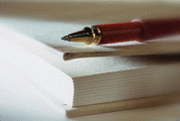Scientific Writing-Part 4: Materials and Methods
Materials and methods section is also called the Procedures section. Often in field-based studies, there is a need to describe the study area in greater detail than is possible in the Introduction. Authors will describe the study region in general terms in the Introduction and then describe the study site and climate in detail in the Materials and Methods section. So the main purpose of the Materials and Methods section is to provide enough detail for a competent worker to repeat your study and reproduce the results. The scientific method requires that your results be reproducible, and you must provide a basis for repetition of the study by others. Since theses, reports and papers are likely to be used by your successors in the lab and by other scientists, as sourcebooks of methods, it is important that procedures are well documented and that details are correct. Once you've left the lab, it might be possible to fill in missing information by asking your supervisor or one of your former colleagues, but this is not such an easy option for someone across the
The Materials and Methods section describes your experiment in such a way that it may be repeated exactly. The majority of the information is this section comes from the Procedures section of the experiment, but in the paper, this information should not be a list of steps. Write the Materials and Methods section in paragraph format in past tense. Be sure to include levels of treatment, numbers of replications, and control treatments. If you are working with living organisms, include the species of organism and the sex of the organism if that information is relevant to the experiment. Do not include failed attempts unless the technique used may be tried by other investigators. Do not try to justify your procedures in this section.
Here you describe how you did your experiments and analyzed your results. This is the easiest section to write, and is generally done first. In fact, one of the most common mistakes is for authors of theses and papers to quote irrelevant information, while missing out the essential details.
The purpose of these notes is to help you decide what is, and what is not, important information. Show your materials and methods section to a colleague. Ask if they would have difficulty in repeating your study.
The sub-headings "Study Site", "General Methods" and "Analysis" may be useful, in that order.
Be careful to reference as much in this section as reasonable, and be sure that all references are correct and complete.
Explain how you studied the problem, which should follow logically from the aims. Depending on the kind of data, this section may contain subsections on experimental details, materials used, data collection/sources, analytical or statistical techniques employed, study area, etc. Provide enough detail for the reader to reproduce what you did. Include flowcharts, maps or tables if they aid clarity or brevity. Answer the question "what steps did I follow?" but do not include results yet.
HINT: Writing papers can go more easily if you write this section first. It can help to get you started and keep from being intimidated by the blank computer screen.
Most of all, this section should be organized carefully or the reader will get lost in the details. Also, omit any information that does not directly refer to the results presented. Often writers find this section the easiest to write and therefore it is a good place to start.
2 How to write materials and methods.
2.1 Materials
A common practice is to state that an enzyme was purchased from Sigma, and to quote the town and/or country. Opening Sigma's catalogue will probably reveal that the offending enzyme is available in various specific activities and from various sources. The following example demonstrates one method for listing materials used: Acetaminophen, chloamphenicol, zomepirac, and probencid were purchased from Sigma Chemical Co. (
On the other hand, Materials available off the shelf should be described exactly (Licor underwater quantum sensor, Model LI 192SB) and sources of materials should be given if there is variation in quality among supplies. It is particularly important to specify the source of that special reagent, which isn't available commercially, but you or your supervisor scrounged it (sorry - obtained it as a gift) from someone. You might not be very popular for revealing your source (but you could tell your benefactor that there's a profit to be made). Appropriate details (e.g. purity) of special materials should be included, especially if they were used as analytical standards. Note that the first time you mention a chemical or important piece of equipment you must give its source, which helps those repeating your work. In my example, mithramycin and Citifluor were mentioned for the first time, unlike PIPES.
No one, nowadays, needs to point out that distilled water was used for preparation of solutions and readers in the developed world will probably assume that you used analytical grade chemicals where these were available. It would, however, be useful to state where HPLC-grade materials, recrystallized chemicals and redistilled solvents are necessary. It would also be appropriate to mention the use of low quality chemicals were used (perhaps bags of sugar instead of Analar sucrose), if their use could conceivably affect the results.
2.2 Instrumentation
Many academics have a poor understanding of the equipment in their laboratory, knowing little more than what it's called, who made it, how much it cost and who funded its purchase; everything else is left to the long-suffering lab. technician. Not surprisingly, inappropriate information finds its way into manuscripts for papers, which is not a good example to set to research students. It is likely that the poor description will go unnoticed, since the referees probably know even less about the technique and the equipment than the authors of the manuscript.
The information which is almost always included in methods - and which is usually of little importance - is the manufacturer of the equipment. Would you be put off trying to do an HPLC analysis just because the authors of the method you want to use specified a Waters HPLC system? Of course not. Similarly, it doesn't usually matter which electrophoresis power supply, spectrophotometer or centrifuge you used. In some cases the equipment will be unusual or have some special specification, in which cases it would be appropriate to specify the manufacturer and model. Modifications to equipment or equipment constructed specifically for the study should be carefully described in detail.
Consider a simple example in which gas chromatography was used to measure something or other. Having decided that it is not necessary to advertise the manufacturer, what information should go in the Methods section and what should be omitted? Details of the chromatography column (dimensions, details of stationary phase), carrier gas, detector type, temperature and, possibly, split ratio should be included. Assuming that the machine is used according to the handbook, there is no need to include such details as the hydrogen/air flow and injection port/detector temperatures for the flame-ionization detector.
2.3 Methods
You need not describe “every” detail if you used a method that was published elsewhere; you cite your source. For instance, "Nuclei in fixed hyphae were stained with the DNA-specific stain, mithramycin, following the method of Heath (1980)." Remember to have full details of where to find Heath (1980) in your reference list.
But you should try to get a good balance between detail and citation. Even if everything you do has been done exactly like the cited method, it helps to give a short description. This makes your paper easier to read, which you will remember is the most important rule of writing. So, for example, even if you followed Heath's (1980) method exactly you might say, "Briefly, fixed hyphae were stained for 5 min in 100ug/ml mithramycin (a gift of Pfizer, Pointe Claire-Dorval, PQ) in PIPES buffer, rinsed in plain buffer and mounted in Citifluor (Marivac, Halifax, NS)." If your reader wants more information, it is in Heath's paper. You would need to describe any changes from your published "standard", and explain substantial ones.
If you have no reference to cite for details of your methods, you must state every essential step so that your reader could repeat your experiment. Give recipes for solutions, and when they were applied and for how long. Following a published example will help with style. Avoid shopping lists for standard glassware and equipment. Be sure to indicate aspects of your procedure that, if done otherwise, might well have caused the results to be different. These facts will be important in comparing your results to what others may have seen when using the same or similar procedures.
The method used to prepare reagents, fixatives, and stains should be stated exactly, though often reference to standard recipes in other works will suffice. Ordinary statistical methods should be used without comment; Be precise in describing measurements and include errors of measurement.
If modifications were made to a previously published procedure, list the modifications and the reasons why they were made.
The reader who looks up a reference should not discover there another reference to an earlier article. It is the author's responsibility to do all the research, find the original description of any procedure and include that reference with any modifications. When you include a reference to a procedure, be sure that the reference describes the procedure precisely the way you did it; another scientist should not have to call you with questions. If you modified a procedure, use the original reference, but be sure to reference the modifications clearly and concisely. Most of us have published our primary procedures enough so that we can easily refer to the primary publication, which includes all the methods and modifications we have used with a specific procedure. But if it is something new and different, you have an obligation to the reader to include these modifications because otherwise it is not a scientific communication.
General methods belong in this section; whereas, specific details of particular experiments belong in the results section. Use labels, such as "Standard Assay" or "Buffer B", for general procedures described here to avoid repetition when these procedures are referred to in other sections of the manuscript. Include everything needed to reproduce your experiment and everything that places a limitation on the results of your research. Do not include trivial information or information that unnecessarily questions your ability to perform. research.
If you describe an experiment from the lab manual, do not simply refer to the procedures listed in the lab manual. Write these procedures concisely, but in paragraph form. The difficulty comes as you decide the level of detail to include in your paragraphs. You must determine which details are essential for the investigator to repeat the experiment. For example, if in your experiment you incubate potato pieces in different concentrations of sucrose solution, it would not be necessary to explain that the pieces were incubated in plastic cups labeled with a wax marking pencil. In this case, the molarity of the sucrose solutions, the size of the potato pieces and how they were obtained, and the amount of incubation solution are the important items to include.
When procedures from a lab book or another report are followed exactly, simply cite the work, noting that details can be found in that particular source. However, it is still necessary to describe special pieces of equipment and the general theory of the assays used. This can usually be done in a short paragraph, possibly along with a drawing of the experimental apparatus.
What is wrong with the following description of methods: "Polynomial regression was used to analyze the effect of temperature on the duration of gypsy moth larval development. The analysis was performed using the JLM software (SAS Institute, 1992). Data was imported into the worksheet in the ASCII format: column 1 was temperature, and column 2 was time of larval development. Temperature was considered an independent variable, X, and time of larval development was considered a dependent variable, Y. To estimate regression coefficients we selected menu items "Analyze/Fit X by Y".
2.4 Miscellaneous
It is common to find see reference to 'an adaptation of A's method' or 'a slight modification of the procedure described by B'. This is useless and inexcusable: you should either give details of the changes or decide that they are too trivial to merit comment.
'Room temperature' is another worthless description, since the reader's crystal ball may be away for repair. An approximate value or range should be quoted.
It is common in reports and theses to describe, in detail, standard methods, but this must be avoided in the manuscript. for a paper. Here it is appropriate to cite the appropriate reference, along with details of any modifications (provided that there are no major differences). Be sure to cite the paper which describes the method because it is infuriating to find just another reference to the source of the method! The best (or worst) example that I have found (so far) was when I had to plough through a series of six papers before locating the recipe for a reagent for electron microscopy.
It is generally accepted that rpm should be converted into g force (note that it is customary to quote maximum rather than average g force) when describing the use of centrifuges. Conversion tables are generally available; if not the g force can be calculated using the from the speed and maximum radius for the rotor.
Descriptions such as 'phosphate buffer' must be avoided - this might mean potassium phosphate, sodium phosphate or Sorensen's buffer (which contains both these cations!). Similarly, salts should not be referred to as acetate or succinate and it should be clear, throughout your thesis, report or paper, whether concentrations refer to the salt or to the free acid. And was it disodium EDTA or tetra-sodium EDTA that you used? You have, no doubt, had to make educated guesses when trying to follow your predecessors' work, so take the trouble to remove ambiguity from what you write (and this doesn't just apply to Materials & Methods).
The Materials & Methods section should be the easiest part of a document to write, since there is nothing controversial, unless you forgot to make adequate notes when you did the work. I'm sure that you would like to be remembered as the creator of the Grand Unifying Theory, rather than as a scientific fraud because none of your experiments could ever be repeated by anyone else!
2.5 Order
The usual order of presentation of methods is chronological, however related methods may need to be described together and strict chronological order cannot always be followed. If your methods are new (unpublished), you must provide all of the detail required to repeat the methods. However, if a method has been previously published in a standard journal, only the name of the method and a literature reference need be given.
2.6 Finally, write this section in the third person, past tense, passive voice. Do not say, "I boiled three flasks."; do say, "Three flasks were boiled." Above all, do not write this like a cookbook. Do not say, "After 24 h, examine the tubes for growth."; do say, "After 24 h, tubes were examined for growth."
2.7 Generally, you will have to explain how your data were collected. How were your specimens grown and/or what growth phase were they in? If cell numbers were monitored, how was this done and at what intervals? If morphology was examined, what aspects were considered and how were they described or quantified? For experimental reports, quantification is a more rigorous form. of reporting than description, but often they are combined. Avoid 'many', 'some', or 'a few' in favour of '>80%', 'half', or '<10%'.
2.8 After reading "Materials and Methods" your colleague from another university should be able to repeat your experiment. If there is a simple well-known procedure then it is better to avoid its description. For example, if you use commercial software, don't describe your actions which are specific to this software: what keys did you push and where you click your mouse.
2.9 Therefore, this section will be written in past tense. The goals of this section are for the author to describe what organisms were studied, where they were studied, when they were studied, and how they were studied. Any relevant field information, descriptions of the species studied, equipment used, or methods of data analysis are to be clearly described such that another person could repeat the study. Often, an author is following the work or methods of another researcher. In this scenario, it is acceptable to reference the other work rather than publish the procedure again.
-----------------------------------------------------------------------------------------------------------------------------------
General rules:
Materials and methods:
· List materials used, how were they used, and where and when was the work done (especially important in field studies)
· Describe special pieces of equipment and the general theory of the analyses or assays used
· Provide enough detail for the reader to understand the experiment without overwhelming him/her. When procedures from a lab book or another report are followed exactly, simply cite the work and note that details can be found there
Be sure to remember:
- Give complete taxonomic information.
- Describe all equipment.
- Include composition, source, and quantities of chemical substances, growth media, test solutions, etc.
- Describe your procedures in detail.
- For field studies, include where and when. Describe the features of your site and possibly include relevant maps, drawings, or photographs. Be sure to include year, month, day, time of day, etc.
MATERIALS AND METHODS
1. How did you answer this question? There should be enough information here to allow another scientist to repeat your experiment. Look at other papers that have been published in your field to get some idea of what is included in this section.
2. If you had a complicated protocol, it may helpful to include a diagram, table or flowchart to explain the methods you used.
3. Do not put results in this section. You may, however, include preliminary results that were used to design the main experiment that you are reporting on. ("In a preliminary study, I observed the owls for one week, and found that 73 % of their locomotor activity occurred during the night, and so I conducted all subsequent experiments between 11 pm and 6 am.")
4. Mention relevant ethical considerations. If you used human subjects, did they consent to participate. If you used animals, what measures did you take to minimize pain?
CONTENTS
How did you study the problem?
What did you use?
(May be subheaded as Materials)
What materials, subjects, and equipment (chemicals, experimental animals, apparatus, etc.) did you use?
(These may be subheaded Animals, Reagents, etc.)
How did you proceed?
(May be subheaded as Methods or Procedures)
What steps did you take? (These may
be subheaded by experiment, types of assay, etc.)
REQUIREMENTS, ADVICE
Provide enough detail for replication.
For a journal article, include, for example, genus, species, strain of organisms; their source, living conditions, and care; and sources (manufacturer, location) of chemicals and apparatus.
Order procedures chronologically or by type
of procedure (subheaded) and chronologically within type.
Use past tense to describe what you did.
Quantify when possible: concentrations, measurements, amounts (all metric); times (24-hour clock); temperatures (centigrade).
Don't include details of common statistical procedures.
Don't mix results with procedures.
转发请注明出处, 敬请持续关注-gfzhang@home.ipe.ac.cn
TAG:
-
 引用
删除
piaoliang110mei / 2008-11-16 11:03:03
引用
删除
piaoliang110mei / 2008-11-16 11:03:03
- very impressive!
-
 引用
删除
michael_b_rex / 2008-11-15 14:05:43
引用
删除
michael_b_rex / 2008-11-15 14:05:43
- good job!thanks!
标题搜索
日历
|
|||||||||
| 日 | 一 | 二 | 三 | 四 | 五 | 六 | |||
| 1 | 2 | 3 | 4 | ||||||
| 5 | 6 | 7 | 8 | 9 | 10 | 11 | |||
| 12 | 13 | 14 | 15 | 16 | 17 | 18 | |||
| 19 | 20 | 21 | 22 | 23 | 24 | 25 | |||
| 26 | 27 | 28 | 29 | 30 | 31 | ||||
我的存档
数据统计
- 访问量: 14919
- 日志数: 52
- 建立时间: 2008-07-22
- 更新时间: 2012-10-15






